RBSE Solutions for Class 12 Maths Chapter 3 Matrices Ex 3.1
Rajasthan Board RBSE Solutions for Class 12 Maths Chapter 3 Matrices Ex 3.1 Textbook Exercise Questions and Answers.
Rajasthan Board RBSE Solutions for Class 12 Maths in Hindi Medium & English Medium are part of RBSE Solutions for Class 12. Students can also read RBSE Class 12 Maths Important Questions for exam preparation. Students can also go through RBSE Class 12 Maths Notes to understand and remember the concepts easily.
RBSE Class 12 Maths Solutions Chapter 3 Matrices Ex 3.1
Question 1.
In the matrix A = \(\left[\begin{array}{cccc} 2 & 5 & 19 & -7 \\ 35 & -2 & 5 / 2 & 12 \\ \sqrt{3} & 1 & -5 & 17 \end{array}\right]\)
Write:
(i) the order of the matrix
Answer:
There are 3 rows and 4 columns in matrix A. So order of matrix A is 3 × 4.

(ii) the number of elements
Answer:
Since, number of rows = 3 and number of columns = 4
∴ Number of elements = 3 × 4 = 12
(iii) the elements a13, a21, a33, a24, a23
Answer:
a13 = Common element of first row and third column = 19
a21 = Common element of second row and first column = 35
a33 = Common element of third row and third column = - 5
a24 = Common element of second row and fourth column = 12
a23 = Common element of second row and third column = 5/2
Question 2.
If a matrix has 24 elements, what are the possible orders it can have ? What if it has 13 elements ?
Answer:
Matrix has 24 elements. So, its possible orders are as follows:
1 × 24, 24 × 1, 2 × 12, 12 × 2, 3 × 8, 8 × 3, 4 × 6, 6 × 4.
When elements are 13 then orders are 1 × 13 and 13 × 1.
Question 3.
If a matrix has 18 elements, what are the possible oders it can have ? What if it has 5 elements?
Answer:
When matrix has 18 elements, then possible orders are as follows:
1 × 18, 18 × 1, 2 × 9, 9 × 2, 3 × 6, 6 × 3
It it has 5 elements then oders are 1 × 5 and 5 × 1.

Question 4.
Construct a 2 × 2 matrix, A = [aij], whose elements are given by:
(i) aij = \(\frac{(i+j)^{2}}{2}\)
Answer:
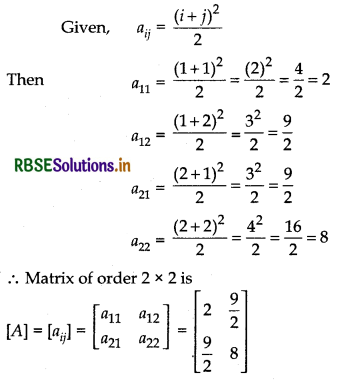
(ii) aij = \(\frac{i}{j}\)
Answer:
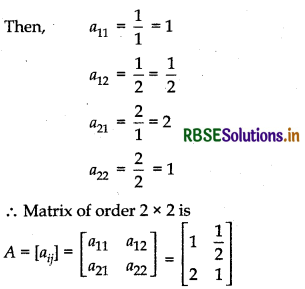

(iii) aij = \(\frac{(i+2 j)^{2}}{2}\)
Answer:
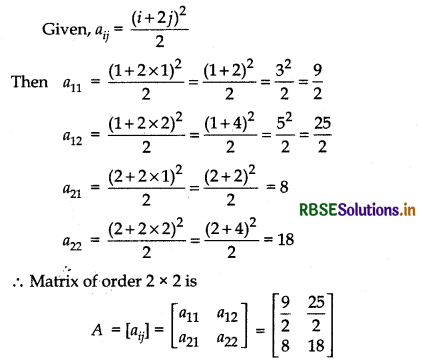
Question 5.
Construct a 3 × 4 matrix, whose elements are obtained in the following way:
(i) aij = \(\frac{1}{2}\) |- 3i + j |
Answer:
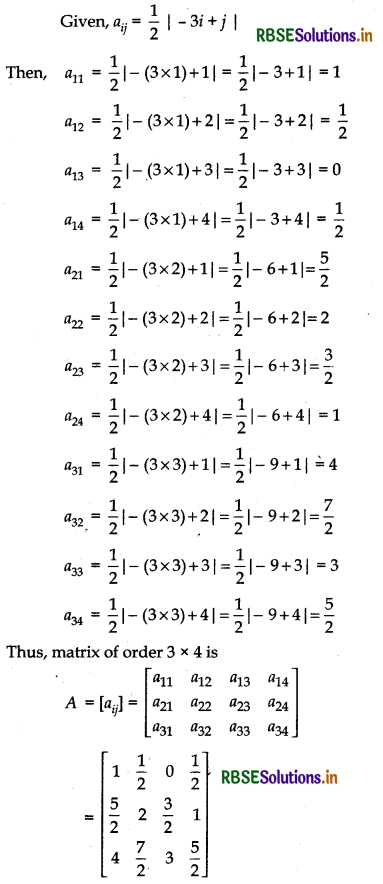

(ii) aij = 2i - j
Answer:
Given, aij = 2i - j
Then
a11 = 2 × 1 - 1 = 2 - 1 = 1
a12 = 2 × 1 - 2 = 2 - 2 = 0
a13 = 2 × 1 - 3 = 2 - 3 = - 1
a14 = 2 × 1 - 4 = 2 - 4 = - 2
a21 = 2 × 2 - 1 = 4 - 1 = 3
a22 = 2 × 2 - 2 = 4 - 2 = 2
a23 = 2 × 2 - 3 = 4 - 3 = 1
a24 = 2 × 2 - 4 = 4 - 4 = 0
a31 = 2 × 3 - 1 = 6 - 1 = 5
a32 = 2 × 3 - 2 = 6 - 2 = 4
a33 = 2 × 3 - 3 = 6 - 3 = 3
a34 = 2 × 3 - 4 = 6 - 4 = 2
Thus, matrix of order 3 × 4 is
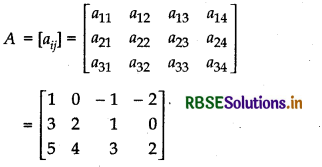
Question 6.
Find the values of x, y and z from the following equations:
(i) \(\left[\begin{array}{ll} 4 & 3 \\ x & 5 \end{array}\right]=\left[\begin{array}{ll} y & z \\ 1 & 5 \end{array}\right]\)
Answer:
Given, \(\left[\begin{array}{ll} 4 & 3 \\ x & 5 \end{array}\right]=\left[\begin{array}{ll} y & z \\ 1 & 5 \end{array}\right]\)
On comparing corresponding elements, we get
4 = y, 3 = z, x = 1
Thus, x = 1, y = 4, z = 3
(ii) \(\left[\begin{array}{cc} x+y & 2 \\ 5+z & x y \end{array}\right]=\left[\begin{array}{cc} 6 & 2 \\ 5 & 8 \end{array}\right]\)
Answer:
Given \(\left[\begin{array}{cc} x+y & 2 \\ 5+z & x y \end{array}\right]=\left[\begin{array}{cc} 6 & 2 \\ 5 & 8 \end{array}\right]\)
On comparing corresponding elements, we get
x + y = 6 .... (i)
5 + z = 5 ..... (ii)
and xy = 8 ..... (iii)
From equation (iii) putting, y = \(\frac{8}{x}\) in equation (i), we get
x + \(\frac{8}{x}\) = 6 ⇒ x2 + 8 = 6x
⇒ x2 - 6x + 8 = 0 ⇒ (x - 4) (x - 2) = 0
∴ x = 4, x = 2
Putting x = 4 in equation (i), we get
4 + y = 6 ⇒ y = 6 - 4 = 2
∴ y = 2
When x = 2, then from equation (i), we get
2 + y = 6 ⇒ y = 6 - 2 = 4
∴ y = 4
and 5 + z = 5 ∴ z = 5 - 5 = 0
Thus, x = 2, y = 4, z = 0

(iii) \(\left[\begin{array}{c} x+y+z \\ x+z \\ y+z \end{array}\right]=\left[\begin{array}{l} 9 \\ 5 \\ 7 \end{array}\right]\)
Answer:
Given, \(\left[\begin{array}{c} x+y+z \\ x+z \\ y+z \end{array}\right]=\left[\begin{array}{l} 9 \\ 5 \\ 7 \end{array}\right]\)
On comparing corresponding elements, we get
x + y + z = 9 ...... (i)
x + z = 5 ....... (ii)
y + z = 7 ...... (iii)
From equation (i) and (ii)
y = 9 - 5 = 4
From equation (i) and (iii)
x = 9 - 7 = 2
In equation (i) putting y = 4, x = 2
2 + 4 + z = 9 ⇒ z = 9 - 6
∴ z = 3
Thus, x = 2, y = 4, z = 3
Question 7.
Find the values of a, b, c and d from equation:
\(\left[\begin{array}{cc} a-b & 2 a+c \\ 2 a-b & 3 c+d \end{array}\right]=\left[\begin{array}{rr} -1 & 5 \\ 0 & 13 \end{array}\right]\)
Answer:
Given, \(\left[\begin{array}{cc} a-b & 2 a+c \\ 2 a-b & 3 c+d \end{array}\right]=\left[\begin{array}{rr} -1 & 5 \\ 0 & 13 \end{array}\right]\)
Comparing corresponding elements, we get
a - b = - 1 ..... (i)
2a + c = 5 ..... (ii)
2a - b = 0 ...... (iii)
3c + d = 13 ...... (iv)
Solving equation (i) and (ii), we get
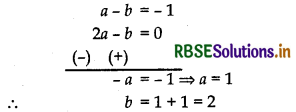
Putting a = 1 in equation (ii), we get
2 × 1 + c = 5 ⇒ c = 5 - 2 = 3
Putting c = 3 in equation (iv), we get
3 × 3 + d = 13 ⇒ d = 13 - 9
∴ d = 4
Thus, a = 1, b = 2, c = 3, d = 4

Question 8.
A = [aij]m × n is a square matrix, if
(A) m < n (B) m > n
(C) m = n
(D) None of these
Answer:
Number of rows and columns are equal in a square matrix, i.e.,
Number of rows = Number of columns (m = n)
Thus, option (C) is correct.
Question 9.
Which of the given values of x and y make the following pair of matrices are equal:
\(\left[\begin{array}{cc} 3 x+7 & 5 \\ y+1 & 2-3 x \end{array}\right],\left[\begin{array}{cc} 0 & y-2 \\ 8 & 4 \end{array}\right]\)
(A) x = - \(\frac{1}{3}\), y = 7
(B) Not impossible to find
(C) y = 7, x = -\(\frac{2}{3}\)
(D) x = - \(\frac{1}{3}\), y = -\(\frac{2}{3}\)
Answer:
In two equal matrices, corresponding elements are equal i.e.,
3x + 7 = 0 and 2 - 3x = 4
On solving these equations, we get
x = - \(\frac{7}{3}\) and x = - \(\frac{2}{3}\)
Here, x has two values, which is not possible.
Thus, (B) is correct.

Question 10.
What will be the number of matrices of order 3 × 3 matrices whose each entry is 0 or 1 ?
(A) 27
(B) 18
(C) 81
(D) 512
Answer:
There will be 9 elements in matrix of order 3 × 3, so we can place either 0 or 1 at each place.
Total number of ways to fill places of 0 = 29 = 512
∴ Possible number of matrices = 512
Thus (D) is correct.

- RBSE Class 12 Maths Notes Chapter 13 Probability
- RBSE Class 12 Maths Notes Chapter 12 Linear Programming
- RBSE Class 12 Maths Notes Chapter 11 Three Dimensional Geometry
- RBSE Class 12 Maths Notes Chapter 10 Vector Algebra
- RBSE Class 12 Maths Notes Chapter 9 Differential Equations
- RBSE Class 12 Maths Notes Chapter 8 Application of Integrals
- RBSE Class 12 Maths Notes Chapter 7 Integrals
- RBSE Class 12 Maths Notes Chapter 6 Application of Derivatives
- RBSE Class 12 Maths Notes Chapter 5 Continuity and Differentiability
- RBSE Class 12 Maths Notes Chapter 4 Determinants
- RBSE Class 12 Maths Notes Chapter 3 Matrices